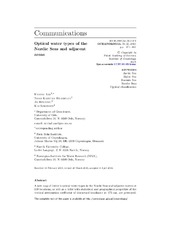Blar i forfatter "Sørensen, Kai"
-
The advective origin of an under-ice spring bloom in the Arctic Ocean using multiple observational platforms
Johnsen, Geir; Norli, Marit; Moline, Mark A.; Robbins, Ian; Quillfeldt, Cecilie von; Sørensen, Kai; Cottier, Finlo Robert; Berge, Jørgen (Journal article; Tidsskriftartikkel; Peer reviewed, 2018-02-13)Under-ice blooms of phytoplankton in the Chukchi Sea have been observed, with strong implications for our understanding of the production regimes in the Arctic Ocean. Using a combination of satellite remote sensing of phytoplankton biomass, in situ observations under sea ice from an autonomous underwater vehicle (AUV), and in vivo photophysiology, we examined the composition, magnitude and origin ... -
Autonomous Surface and Underwater Vehicles as Effective Ecosystem Monitoring and Research Platforms in the Arctic—The Glider Project
Camus, Lionel; Andrade, Hector; Aniceto, Ana Sofia; Aune, Magnus; Bandara, Kanchana; Basedow, Sünnje Linnéa; Christensen, Kai Håkon; Cook, Jeremy; Daase, Malin; Dunlop, Katherine Mary; Falk-Petersen, Stig; fietzek, Peter; Fonnes, Gro; Ghaffari, Peygham; Gramvik, Geir; Graves, Inger; Hayes, Daniel; Langeland, Tom; Lura, Harald; Marin, Trond Kristiansen; Nøst, Ole Anders; Peddie, David; Pederick, Joel; Pedersen, Geir; Sperrevik, Ann Kristin; Sørensen, Kai; Tassara, Luca; Tjøstheim, Sigurd; Tverberg, Vigdis; Dahle, Salve (Journal article; Tidsskriftartikkel; Peer reviewed, 2021-10-12)Effective ocean management requires integrated and sustainable ocean observing systems enabling us to map and understand ecosystem properties and the effects of human activities. Autonomous subsurface and surface vehicles, here collectively referred to as “gliders”, are part of such ocean observing systems providing high spatiotemporal resolution. In this paper, we present some of the results achieved ... -
Estimation of upward radiances and reflectances at the surface of the sea from above-surface measurements
Kleiv, Øyvind; Folkestad, Are; Høkedal, Jo; Aas, Eyvind; Sørensen, Kai (Journal article; Tidsskriftartikkel; Peer reviewed, 2015-10-02)During 4 field days in the years 2009–2011, 22 data sets of measurements were collected in the inner Oslofjord, Norway. The data consist of recordings of spectral nadir radiances in air and water as well as spectral downward irradiance in air. The studied wavelengths are 351, 400, 413, 443, 490, 510, 560, 620, 665, 681, 709 and 754 nm. The water-leaving radiance and the reflected radiance at the ... -
The impact of advection on a Subarctic fjord food web dominated by the copepod Calanus finmarchicus
Basedow, Sünnje Linnéa; Renner, Angelika; Espinasse, Boris Dristan; Falk-Petersen, Stig; Graeve, Martin; Bandara, Kanchana; Sørensen, Kai; Eiane, Ketil; Hagen, Wilhelm (Journal article; Tidsskriftartikkel; Peer reviewed, 2024-05-04)Fjord and shelf food webs are frequently supplemented by the advection of external biomass, which in high-latitude seas often comes in the form of lipid-rich copepods that can support a wide range of fish species, including Northeast Arctic cod (Gadus morhua). A seasonal match or mismatch at the lower trophic levels (phytoplankton and zooplankton) is central in determining how much energy and biomass ... -
Optical water types of the Nordic Seas and adjacent areas
Aas, Eyvind; Højerslev, Niels Kristian; Høkedal, Jo; Sørensen, Kai (Journal article; Tidsskriftartikkel; Peer reviewed, 2013-05-20)A new map of Jerlov's optical water types in the Nordic Seas and adjacent waters at 139 locations, as well as a table with statistical and geographical properties of the vertical attenuation coefficient of downward irradiance at 475 nm, are presented. The data analysis is based on 715 recordings at different stations, at latitudes between 54° and 82°N, and longitudes between 31°W and 49°E, obtained ...


 English
English norsk
norsk



